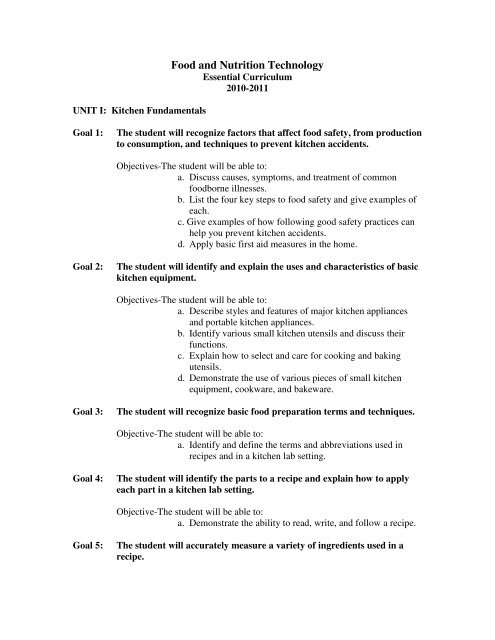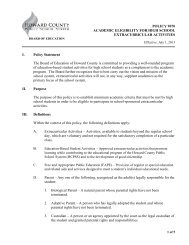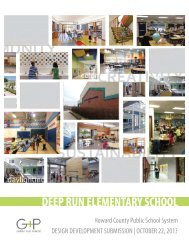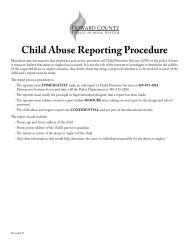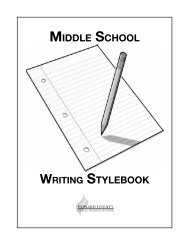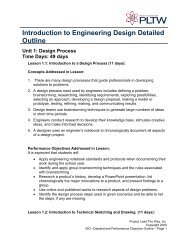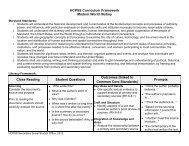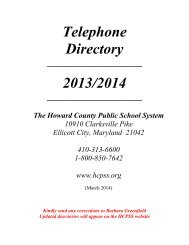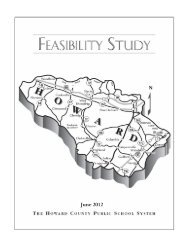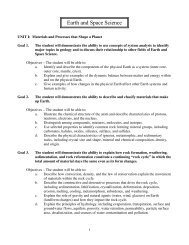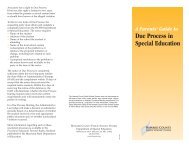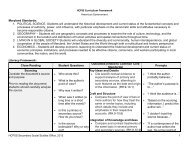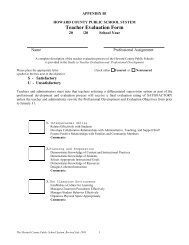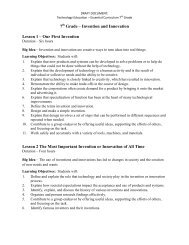Foods and Nutrition
Foods and Nutrition
Foods and Nutrition
Create successful ePaper yourself
Turn your PDF publications into a flip-book with our unique Google optimized e-Paper software.
UNIT I: Kitchen FundamentalsFood <strong>and</strong> <strong>Nutrition</strong> TechnologyEssential Curriculum2010-2011Goal 1:The student will recognize factors that affect food safety, from productionto consumption, <strong>and</strong> techniques to prevent kitchen accidents.Objectives-The student will be able to:a. Discuss causes, symptoms, <strong>and</strong> treatment of commonfoodborne illnesses.b. List the four key steps to food safety <strong>and</strong> give examples ofeach.c. Give examples of how following good safety practices canhelp you prevent kitchen accidents.d. Apply basic first aid measures in the home.Goal 2:The student will identify <strong>and</strong> explain the uses <strong>and</strong> characteristics of basickitchen equipment.Objectives-The student will be able to:a. Describe styles <strong>and</strong> features of major kitchen appliances<strong>and</strong> portable kitchen appliances.b. Identify various small kitchen utensils <strong>and</strong> discuss theirfunctions.c. Explain how to select <strong>and</strong> care for cooking <strong>and</strong> bakingutensils.d. Demonstrate the use of various pieces of small kitchenequipment, cookware, <strong>and</strong> bakeware.Goal 3:The student will recognize basic food preparation terms <strong>and</strong> techniques.Objective-The student will be able to:a. Identify <strong>and</strong> define the terms <strong>and</strong> abbreviations used inrecipes <strong>and</strong> in a kitchen lab setting.Goal 4:The student will identify the parts to a recipe <strong>and</strong> explain how to applyeach part in a kitchen lab setting.Objective-The student will be able to:a. Demonstrate the ability to read, write, <strong>and</strong> follow a recipe.Goal 5:The student will accurately measure a variety of ingredients used in arecipe.
Objectives-The student will be able to:a. Demonstrate the ability to measure dry <strong>and</strong> liquidingredients using the appropriate tools <strong>and</strong> techniques.b. Demonstrate how to convert a recipe to a new yield.Goal 6:The student will apply the principles of time management <strong>and</strong>appropriate lab procedures to working in a kitchen lab setting.Objectives-The student will be able to:a. Identify the order <strong>and</strong> timing of all critical preparation stepsin a recipe.b. Develop time-work schedules for each kitchen lab.c. Identify the work areas of each kitchen lab <strong>and</strong> becomefamiliar with where equipment is stored.d. Apply principles of food safety <strong>and</strong> accident prevention ineach kitchen lab.Goal 7:The student will identify the knives most commonly used in a kitchen lab<strong>and</strong> apply the principles of using a knife safely.Objectives-The student will be able to:a. Select appropriate knives for assigned tasks.b. Use knives safely <strong>and</strong> efficiently.c. Apply appropriate cutting techniques according to recipedirections.Goal 8:The student will identify a variety of flavorings <strong>and</strong> seasonings used toenhance a recipe.Objectives-The student will be able to:a. Identify the difference between an herb <strong>and</strong> a spice.b. Identify the uses of herbs <strong>and</strong> spices.c. Apply the principles of using herbs <strong>and</strong> spices in a recipe.UNIT II: Methods of CookingGoal 1:The student will identify, describe, <strong>and</strong> demonstrate the principles ofcooking as applied to meats.Objectives-The student will be able to:a. Explain the three main parts of meat.b. Describe the nutritional value of meat.c. List factors affecting the selection of meats.d. Outline how to properly store meats to maintain theirquality.e. Identify the most common grades of beef.
f. Describe the principles <strong>and</strong> methods of cooking meats.g. Prepare a variety of meat dishes using dry <strong>and</strong> moistcooking methods.Goal 2:The student will identify, describe, <strong>and</strong> demonstrate the principles ofcooking as applied to poultry <strong>and</strong> poultry products.Objectives-The student will be able to:a. List the nutrients found in poultry.b. Identify the most popular types <strong>and</strong> the common forms ofpoultry.c. List factors affecting the selection <strong>and</strong> purchase of poultry.d. Explain how to properly store poultry to maintain itsquality.e. Describe the principles <strong>and</strong> methods of cooking poultry.f. Discuss the importance of cooking poultry until well done.g. Prepare a variety of poultry dishes using dry <strong>and</strong> moistcooking methods.Goal 3:The student will identify, describe, <strong>and</strong> demonstrate the principles ofcooking as applied to fish <strong>and</strong> shellfish.Objectives-The student will be able to:a. List the nutrients found in fish <strong>and</strong> shellfish.b. Describe the categories of fish <strong>and</strong> shellfish <strong>and</strong> list fivemarket forms of fish.c. List factors affecting the selection <strong>and</strong> purchase of fish <strong>and</strong>shellfish.d. Explain how to properly store fish <strong>and</strong> shellfish to maintaintheir quality.e. Describe the principles <strong>and</strong> methods of cooking fish <strong>and</strong>shellfish.f. Explain how to determine when fish is cooking properly<strong>and</strong> completely.g. Prepare a variety of fish <strong>and</strong> shellfish dishes using dry <strong>and</strong>moist cooking methods.Goal 4:The student will identify, describe, <strong>and</strong> demonstrate the principles ofcooking with eggs <strong>and</strong> dairy products.Objectives-The student will be able to:a. List the nutrients found in eggs.b. List the nutrients found in milk <strong>and</strong> dairy products.c. List the factors affecting the selection of milk <strong>and</strong> dairyproducts.
d. Explain how to properly store dairy products to maintaintheir quality.e. List factors affecting the selection <strong>and</strong> purchase of eggs.f. Explain how to properly store eggs to maintain theirquality.g. Outline the parts of an egg.h. Examine the varied roles eggs play including serving as abinder, thickener, leavening agent, <strong>and</strong> emulsifier.i. Demonstrate the ability to cook <strong>and</strong> use eggs appropriatelyaccording to assigned recipe or task.j. Describe guidelines for preventing adverse reactions whencooking with dairy products.k. Demonstrate the ability to prepare a variety of dishes usingmilk, cream, cheese, <strong>and</strong> other dairy products.Goal 5:The student will identify, describe, <strong>and</strong> demonstrate the principles ofcooking as applied to grain products.Objectives-The student will be able to:a. Describe how grains are processed to create food products<strong>and</strong> how this processing can affect the nutritional value ofgrains.b. List a variety of grain products.c. Explain what to look for when buying grains <strong>and</strong> grainproducts.d. Explain how to properly store grains <strong>and</strong> grain products tomaintain their quality.e. List <strong>and</strong> describe at least six grains used throughout theworld.f. Label the parts of a grain kernel <strong>and</strong> identify which partsare used in whole grains.g. Describe how heat <strong>and</strong> liquids affect starches.h. Demonstrate the ability to prepare a variety of grain foodsincluding cereals, rice, <strong>and</strong> pasta.Goal 6:The student will identify, describe, <strong>and</strong> demonstrate the principles ofcooking combination foods including soups, casseroles, <strong>and</strong> hots<strong>and</strong>wiches.Objectives-The student will be able to:a. Define the terms broth, stock, bouillon, bisque, chowder,<strong>and</strong> consommé.b. List methods <strong>and</strong> ingredients used to thicken liquids.c. Demonstrate the ability to make a variety of soupsincluding broth-based <strong>and</strong> milk/cream-based soups.
UNIT III: Consumer Skillsd. Explain how to reheat, serve, cool, <strong>and</strong> freeze soups.e. Define the term casserole <strong>and</strong> give examples of meat <strong>and</strong>meatless casseroles.f. List the basic ingredients in a casserole.g. Discuss why casseroles are an economical meal choice.h. Explain how to reheat, serve, cool, <strong>and</strong> freeze casseroles.i. Demonstrate the ability to prepare a variety of casseroles.j. List a variety of s<strong>and</strong>wiches with cooked fillings.k. Compare <strong>and</strong> contrast grilling <strong>and</strong> broiling as methods forpreparing hot s<strong>and</strong>wiches.l. Demonstrate the ability to prepare a variety of hots<strong>and</strong>wiches.Goal 1:The student will identify <strong>and</strong> describe factors to consider when designing<strong>and</strong> equipping a kitchen.Objectives-The student will be able to:a. Define the term work triangle <strong>and</strong> identify the three mainwork centers that are incorporated in the work triangle.b Outline six basic kitchen floor plans <strong>and</strong> discuss theadvantages <strong>and</strong> disadvantages of each.c. Discuss universal design principles as applied to kitchendesign.d. Describe factors to consider when choosing kitchencomponents including cabinets, countertops, flooring,walls, lighting, ventilation, <strong>and</strong> the electrical system.e. List four large <strong>and</strong> nine portable kitchen appliances.f. Evaluate safety seals, warranties, <strong>and</strong> energy labels asfactors to consider when choosing kitchen appliances.g. Discuss how to conserve resources including water <strong>and</strong>energy <strong>and</strong> how to reduce trash <strong>and</strong> waste when working inthe kitchen.h. Identify <strong>and</strong> describe a variety of table appointmentsincluding dinnerware, flatware, beverageware, linens, <strong>and</strong>hollowware.Goal 2:The student will identify <strong>and</strong> describe factors to consider whendeveloping <strong>and</strong> managing a food budget.Objectives-The student will be able to:a. Discuss factors families <strong>and</strong> individuals consider whendetermining how much to spend on food.b. Discuss the impact of convenience foods on a food budget.
c. List the advantages of using a shopping list whenpurchasing food.d. Compare the prices of the same food product sold indifferent ways: national br<strong>and</strong> versus generic or storebr<strong>and</strong>; economy size versus regular size; supermarketversus discount or warehouse store; canned versus frozen.e. Identify ways to reduce spending on food purchases.Goal 3:The student will identify, describe, <strong>and</strong> demonstrate the principles ofdining etiquette.Objectives-The student will be able to:a. Describe the purpose <strong>and</strong> importance of dining etiquette.b. Create a step-by-step guide for demonstrating properetiquette in a restaurant.c. Compare <strong>and</strong> contrast table settings <strong>and</strong> meal service forformal <strong>and</strong> informal dining.d. Identify <strong>and</strong> describe six different types of meal service.e. Outline the factors to consider when planning a party.f. Define the term hospitality <strong>and</strong> list the duties of ahost/hostess for a formal party.g. Discuss the importance of dining etiquette in the workingworld.h. Compare <strong>and</strong> contrast dining etiquette in other countries<strong>and</strong> cultures.Goal 4:The student will identify <strong>and</strong> describe food-related career opportunities.Objectives-The student will be able to:a. Research career opportunities in hospitality <strong>and</strong> identifythe requirements for entry-level employment in careers ofinterest.b. Outline the requirements for <strong>and</strong> benefits of participationin the HCPSS Culinary <strong>and</strong> Hotel <strong>and</strong> RestaurantManagement Academy programs.c. Research opportunities for postsecondary education <strong>and</strong>training in the hospitality field.UNIT IV: Wellness through FoodGoal 1:The student will identify <strong>and</strong> assess the effects of nutrients required tomaintain good health.Objectives-The student will be able to:a. Divide nutrients into six groups <strong>and</strong> describe theirfunctions.
. Identify food sources of nutrients <strong>and</strong> develop menuscontaining nutrients required for maintaining good health.c. Analyze the effects of various nutrient deficiencies <strong>and</strong>excesses on individuals in various stages of life.d. Explore how their body uses nutrients by explaining theprocesses of digestion, absorption <strong>and</strong> metabolism.Goal 2:The student will recognize the benefits of making healthful food choices<strong>and</strong> create menus supporting a healthy lifestyle.Objectives-The student will be able to:a. Evaluate <strong>and</strong> plan their diets through defining DietaryReference Intakes (DRIs).b. Explain the role of the USDA Food Guide in helping themplan nutritious meals.c. Compare available foods within each food group <strong>and</strong>analyze the benefits of healthful food choices.d. Demonstrate food preparation techniques supportinghealthier living.e. Describe suggestions for limiting processed foods <strong>and</strong>selecting the most healthful options when eating out.Goal 3:The student will examine factors impacting nutrition through their lifecycle.Objectives-The student will be able to:a. Compare the nutritional needs of people in various stagesof the life cycle.b. Compile a list of meal-planning tips to meet the needs ofpeople in different stages of the life cycle.c. Define terms related to special diets.d. Discuss accommodations for people with specific concernsor needs.e. Plan meals based on their current life stage as well aspredict future nutritional needs.Goal 4:The student will recognize the role of exercise <strong>and</strong> weight management inmaintaining good health.Objectives-The student will be able to:a. Identify <strong>and</strong> explain factors impacting energy needs.b. Describe types of physical activity <strong>and</strong> their impact onhealth throughout the lifespan.c. Examine factors impacting weight management <strong>and</strong> explainterms related to determining a healthy weight.
d. Define health risks associated with obesity.e. Discuss current weight <strong>and</strong> lifestyle trends in America <strong>and</strong>contrast with other countries.f. List three common eating disorders <strong>and</strong> explain how theyput physical <strong>and</strong> mental health at risk.g. Develop an individualized plan for maintaining a healthyweight.Goal 5:The student will explore cultural, social, physiological, psychological <strong>and</strong>technological influences on food choices.Objectives-The student will be able to:a. Describe the evolution of food, comparing modern trendsto historic events.b. List steps in the decision-making process <strong>and</strong> explain theimpact on food choices.c. Explain how food improves wellness from physical, social<strong>and</strong> psychological perspectives.d. Outline cultural, social <strong>and</strong> psychological influences onfood choices.e. Define factors affecting the food supply, researching <strong>and</strong>comparing the availability of foods in different countries.f. Describe the impact of technology on foods <strong>and</strong> discuss thepros <strong>and</strong> cons of their developments on nutrition.UNIT V: Cold Food PreparationGoal 1:The student will identify, describe, <strong>and</strong> demonstrate the principles ofpreparing salads <strong>and</strong> dressings.Objectives-The student will be able to:a. List <strong>and</strong> describe seven types of salad.b. Explain how to wash <strong>and</strong> store salad greens.c. List <strong>and</strong> describe two types of combination salads.d. Compare <strong>and</strong> contrast at least eight different types of saladgreens.e. Identify <strong>and</strong> describe four different types of saladdressings.f. Describe the ingredients in a basic vinaigrette dressing <strong>and</strong>use a variety of herbs, spices, <strong>and</strong> other flavorings toprepare a variation of basic vinaigrette.g. Demonstrate the ability to prepare a variety of saladsincluding tossed, arranged, layered, <strong>and</strong> bound salads.Goal 2:The student will identify, describe, <strong>and</strong> demonstrate the principles ofpreparing chilled <strong>and</strong> frozen desserts.
Objectives-The student will be able to:a. Identify <strong>and</strong> describe dairy-based desserts including icecream, sherbet, pudding, <strong>and</strong> gelatin creams.b. Describe the steps in making ice cream <strong>and</strong> sherbet <strong>and</strong>discuss the importance of stirring both products duringfreezing.c. Create a recipe for a dessert salad.d. Demonstrate the ability to prepare a variety of chilled <strong>and</strong>frozen desserts.Goal 3:The student will identify, describe, <strong>and</strong> demonstrate the principles ofpreparing cold s<strong>and</strong>wiches.Objectives-The student will be able to:a. Discuss the origin of the s<strong>and</strong>wich.b Design a cold s<strong>and</strong>wich that includes foods from each ofthe food groups: grains, vegetables, fruits, milk, meats <strong>and</strong>beans.c. List <strong>and</strong> describe types of s<strong>and</strong>wiches from other cultures.d. Demonstrate the ability to prepare a variety of colds<strong>and</strong>wiches using different combinations of breads, fillings,<strong>and</strong> condiments.UNIT VI: Principles of BakingGoal 1:The student will identify, describe, <strong>and</strong> demonstrate the principles ofbaking quick <strong>and</strong> yeast breads.Objectives-The student will be able to:a. List the basic ingredients in baked goods <strong>and</strong> examine theroles of each ingredient in the baking process.b Explain how to select <strong>and</strong> store baked goods.c. Compare <strong>and</strong> contrast cake, bread, <strong>and</strong> all-purpose flour.d. Define the terms batter <strong>and</strong> dough.e. Explain the difference between a quick bread <strong>and</strong> a yeastbread <strong>and</strong> list three examples of each.f. Identify the three gases that make baked products rise.g. List <strong>and</strong> explain the mixing methods for yeast breads.h. Demonstrate the ability to prepare a variety of quick <strong>and</strong>yeast breads.Goal 2:The student will identify, describe, <strong>and</strong> demonstrate the principles ofbaking cookies.Objectives-The student will be able to:
a. Identify <strong>and</strong> describe six different types of cookies.b. Explain how to store cookies to maintain their quality.c. Cite four tips for the proper baking of cookies.d. Discuss what to look for in determining when cookies aredone baking.e. Demonstrate the ability to prepare a variety of cookiesincluding bar, drop, rolled, <strong>and</strong> molded cookies.Goal 3:The student will identify, describe, <strong>and</strong> demonstrate the principles ofbaking cakes.Objectives-The student will be able to:a. List the basic ingredients used in cakes <strong>and</strong> describe theirfunctions.b Compare <strong>and</strong> contrast shortened <strong>and</strong> unshortened cakes <strong>and</strong>list examples of each.c. List the two most common mixing methods for shortenedcakes.d. Discuss the importance of choosing the correct size panwhen baking a cake.e. Describe a variety of methods for embellishing cakes.f. Demonstrate the ability to prepare a variety of cakesincluding shortened <strong>and</strong> unshortened cakes.Goal 4:The student will identify, describe, <strong>and</strong> demonstrate the principles ofbaking pies.Objectives-The student will be able to:a. List the four basic ingredients in pastry dough <strong>and</strong> describehow each ingredient contributes to the tenderness <strong>and</strong>flakiness of the piecrust.b. Describe the principles <strong>and</strong> steps for preparing <strong>and</strong> rollingpastry dough.c. Identify the four types of pies <strong>and</strong> list examples of eachtype.d. List five ingredients that can be used to make a crumb crustfor a pie.e. Describe three methods for embellishing a two-crust pie.f. Demonstrate the ability to prepare a variety of piesincluding fruit, savory, cream, <strong>and</strong> custard pies.Goal 5:The student will identify, describe, <strong>and</strong> demonstrate the principles ofpreparing specialty baked goods including c<strong>and</strong>ies.Objectives-The student will be able to:
UNIT VII: <strong>Foods</strong> of the Worlda. Explain the impact of temperature <strong>and</strong> crystallization inc<strong>and</strong>y making.b. Compare <strong>and</strong> contrast crystalline <strong>and</strong> noncrystallinec<strong>and</strong>ies <strong>and</strong> list examples of each.c. Identify methods for preventing unwanted crystallizationduring c<strong>and</strong>y making.d. Demonstrate the ability to prepare a variety of simplec<strong>and</strong>ies.Goal 1:The student will examine the influence of culture on European foodchoices <strong>and</strong> customs.Objectives-The student will be able to:a. Explain the origin of food customs of Eastern, Western,<strong>and</strong> Northern Europe.b. Describe the influence of climate <strong>and</strong> geography on foodchoices throughout Europe.c. Identify ingredients <strong>and</strong> food staples associated withEastern, Western, <strong>and</strong> Northern Europe.d. Demonstrate the ability to prepare a variety of dishesassociated with Eastern, Western, <strong>and</strong> Northern Europe.Goal 2:The student will examine the influence of culture on Latin American foodchoices <strong>and</strong> customs.Objectives-The student will be able to:a. Explain the origin of food customs of Latin America.b. Describe the influence of climate <strong>and</strong> geography on foodchoices throughout Latin America.c. Identify ingredients <strong>and</strong> food staples associated withcountries <strong>and</strong> regions in Latin America.d. Demonstrate the ability to prepare a variety of dishesassociated with Latin America.Goal 3:The student will examine the influence of culture on Middle Eastern <strong>and</strong>African food choices <strong>and</strong> customs.Objectives-The student will be able to:a. Explain the origin of food customs of the Middle East <strong>and</strong>Africa.b. Describe the influence of climate <strong>and</strong> geography on foodchoices throughout the Middle East <strong>and</strong> Africa.c. Identify ingredients <strong>and</strong> food staples associated withcountries <strong>and</strong> regions in the Middle East <strong>and</strong> Africa.
d. Demonstrate the ability to prepare a variety of dishesassociated with the Middle East <strong>and</strong> Africa.Goal 4:The student will examine the influence of culture on Asian food choices<strong>and</strong> customs.Objectives-The student will be able to:a. Explain the origin of food customs of Asia.b. Describe the influence of climate <strong>and</strong> geography on foodchoices throughout Asia.c. Identify ingredients <strong>and</strong> food staples associated withcountries <strong>and</strong> regions in Asia.d. Demonstrate the ability to prepare a variety of dishesassociated with Asia.Goal 5:The student will examine the influence of culture on Mediterranean foodchoices <strong>and</strong> customs.Objectives-The student will be able to:a. Explain the origin of food customs in the Mediterraneanregion.b. Describe the influence of climate <strong>and</strong> geography on foodchoices throughout the Mediterranean region.c. Identify ingredients <strong>and</strong> food staples associated withMediterranean countries <strong>and</strong> regions.d. Demonstrate the ability to prepare a variety of dishesassociated with the Mediterranean region.Goal 6:The student will examine the influence of culture on regional food choices<strong>and</strong> customs in the United States.Objectives-The student will be able to:a. Identify the origins of foods of the seven main regions ofthe United States.b Describe the influence of climate <strong>and</strong> geography on foodchoices in each of the seven main regions of the UnitedStates.c. Identify ingredients <strong>and</strong> food staples associated with eachof the seven main regions of the United States.d. Demonstrate the ability to prepare a variety of dishesassociated with each region of the United States.


